Having a cruise ship job/working on a cruise ship are maybe the most rewarding experiences you can get for a lifetime. Not only professionally, but also personally, it helps you develop your potentials, skills (some of them you never knew you had), working habits, professional capacities, and much more.
However, working on a cruise ship, surrounded at all times by thousands of people you don’t know, for a long time, far from your home, family, and friends, can be quite challenging for most of us. It involves hard work, long working hours, long contracts, and no day off, but it’s all a part of a routine you get used to surprisingly quickly, as your days pass by much faster than you could imagine. All you have to do is do your job and stick to your schedule.
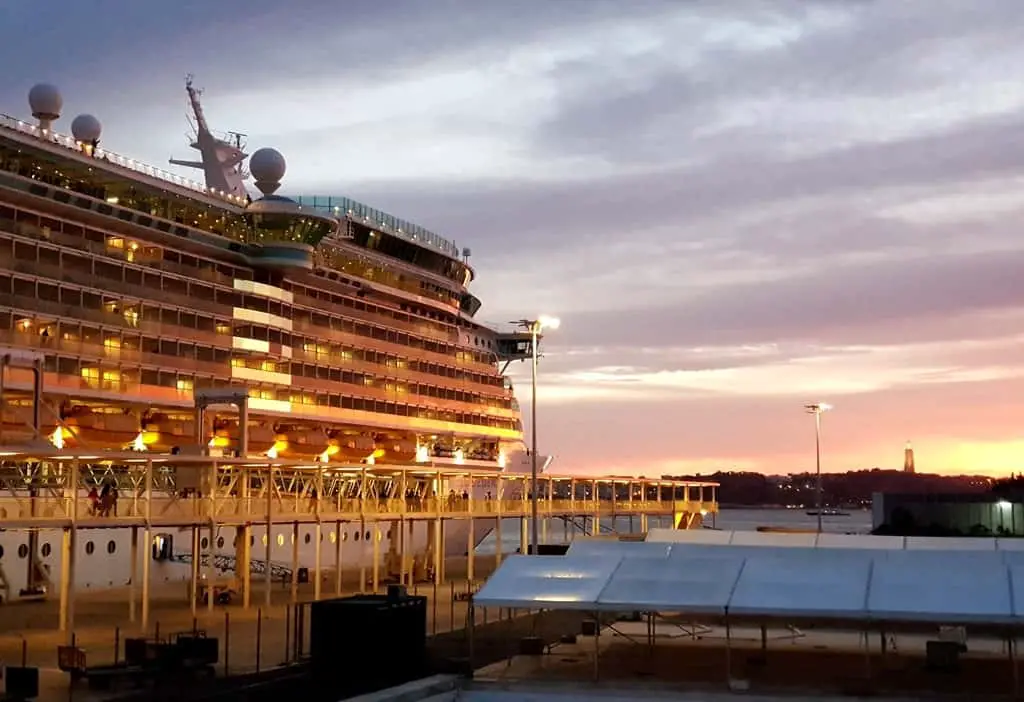
But, is “your job” truly ALL you have to do onboard a cruise ship in reality?
In this article, I’ll share with you 11 things you have to do as part of your cruise job duties, as well as things you would never expect to be required to do while working on a cruise ship.
Please, note that these are not the official extra duties descriptions and they vary on the cruise line. The content of this article is based on my personal experience as a crew member.
If, by any chance, you’re interested in checking out my other cruise ship job-related articles, feel free to do so by clicking the links below.
- 10 Things To Know Before Applying For A Cruise Ship Job
- Working On A Cruise Ship: How To Apply For A Cruise Ship Job?
- Life Of Shore Excursions Staff Onboard A Cruise Ship: Job Description And Daily Duties
- Why Is Shore Excursions Staff One Of The Best Cruise Ship Jobs?
- Life of a Cruise Ship Photographer – Crew Member’s Story
1. Cruise Ship Dry Dock
When I first joined the cruise ship, I had absolutely no idea of what the cruise ship dry dock was. And then, I experienced it on my first contract.
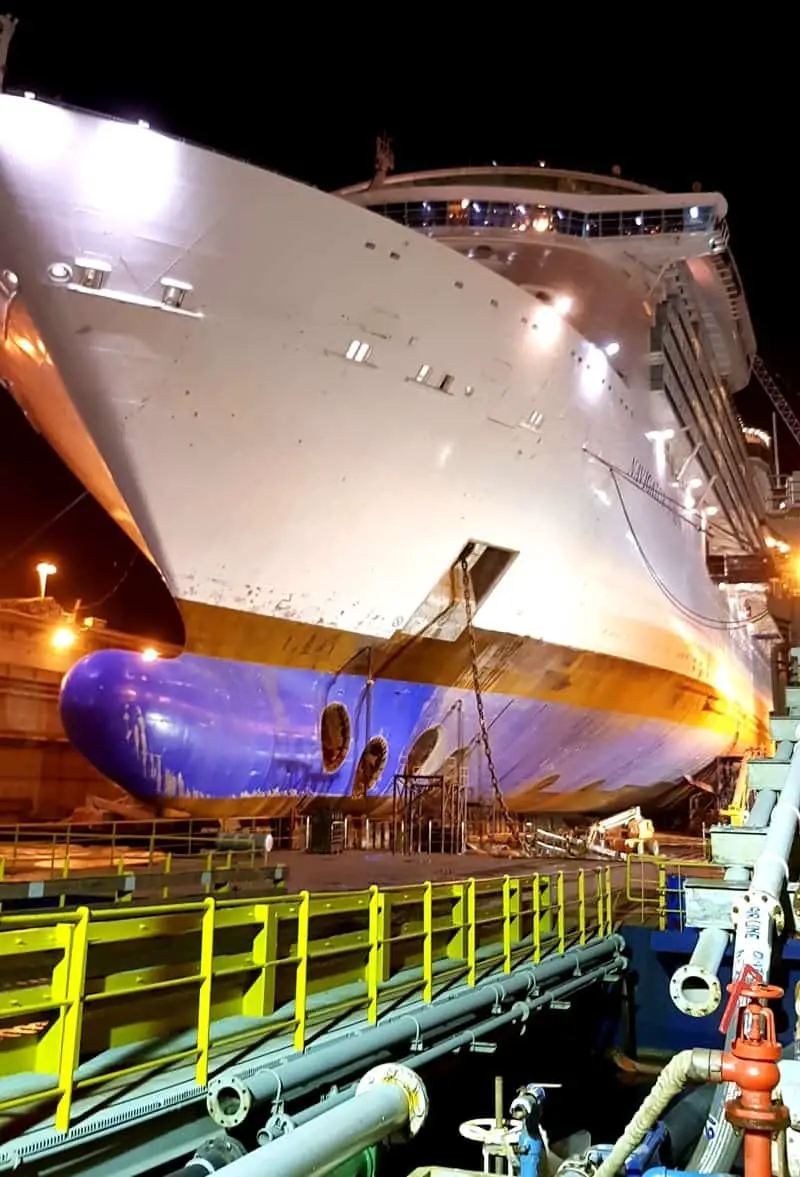
Explained in simple words, a dry dock is a type of dock where the ship is docked for a certain period of time in order to be maintained, repaired, and refurbished. This type of dock allows shipyard workers to access the ship’s hull and other parts of the ship that are normally underwater. The dry dock is required by the International Convention of the Safety of Life at Sea and is performed every few years on every vessel. For passengers cruise ships, the dry dock can last from a few days up to several months, depends on the ship’s condition.
Dry docks are located all across the world, and the one my previous ship had was in Freeport, The Bahamas, and it lasted for two months.
Yep, you heard well. Two months, in the middle of nowhere.
What Does a Dry Dock Mean For Cruise Ship Crew Members?
This entirely depends on the ship management, your contract length, and sometimes your preferences. If your contract is close to the end, probably you’ll be sent home earlier or transferred to another ship. If you are in the beginning or middle of your contract, you’ll probably stay on board during a dry dock, as they will need you afterward when the ship starts sailing again.
Rules don’t exist, and it all depends on your supervisors and business needs.
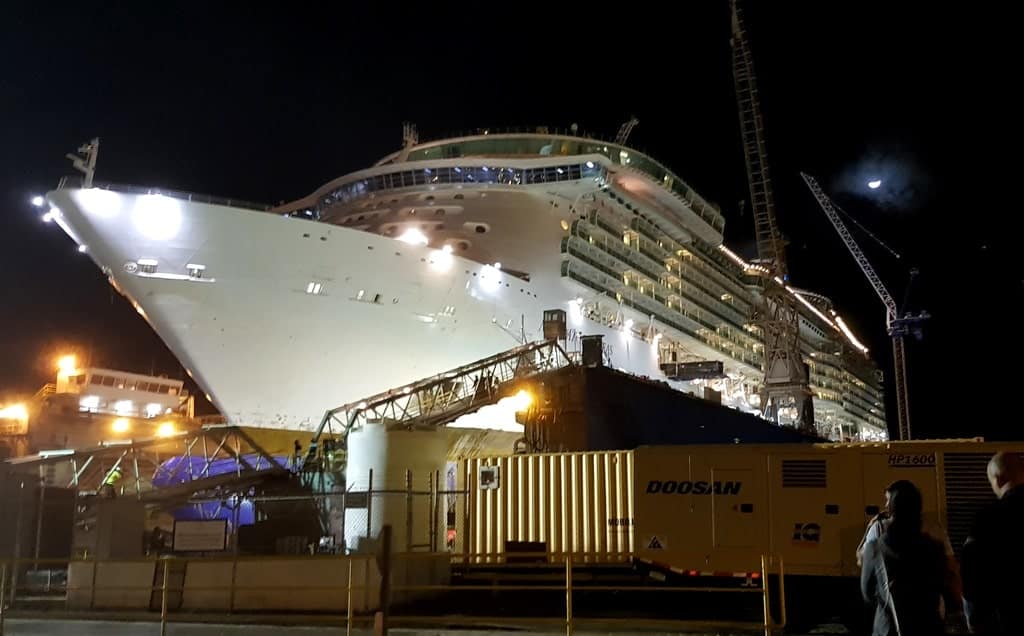
Crew Members’ Duties During a Dry Dock
Crew members who stay on board for a dry dock usually have different duties. The ship is transformed into a huge construction site during a dry dock; a lot of contractor companies and workers come onboard and each company is in charge of repairing and refurbishing specific areas on the ship.
Crew members’ duties consist of helping contractors perform their job, or facilitating their stay on the ship. Crew members from Housekeeping or Restaurant department have a lot of work to do, as they need to clean the contractors’ rooms (contractors usually stay in guest cabins) or prepare food for the whole ship, sometimes along with the fire watch duties. This time no tips, though.
Crew members from the Marine department normally do their regular duties, whereas most of the crew members perform fire watch duties.

Crew members get all necessary safety equipment and are sent to specific areas of the ship to do the fire watch, to help protect ship areas from any fire hazards. The equipment consists of safety clothes and shoes, helmet, safety glasses, masks, and a bottle of water, and every crew member gets a fire extinguisher to use in case of fire hazard. Of course, before this whole process, all crew members go through a detailed training procedure to ensure everyone learns what their duties are.
Some crew members are in charge of dispatching and supervising the teams doing the fire watch (I was a dispatcher when my ship went on a dry dock), and some crew members don’t have the duties at all. Sometimes it doesn’t seem to be fair and many crew members complain they have to do fire watch besides their regular job duties as well, but unfortunately, not everything is organized as it should be. Firewatch can be a very tough activity, but it’s endurable when the dry dock lasts several days. When it lasts longer, it can get very difficult to manage.
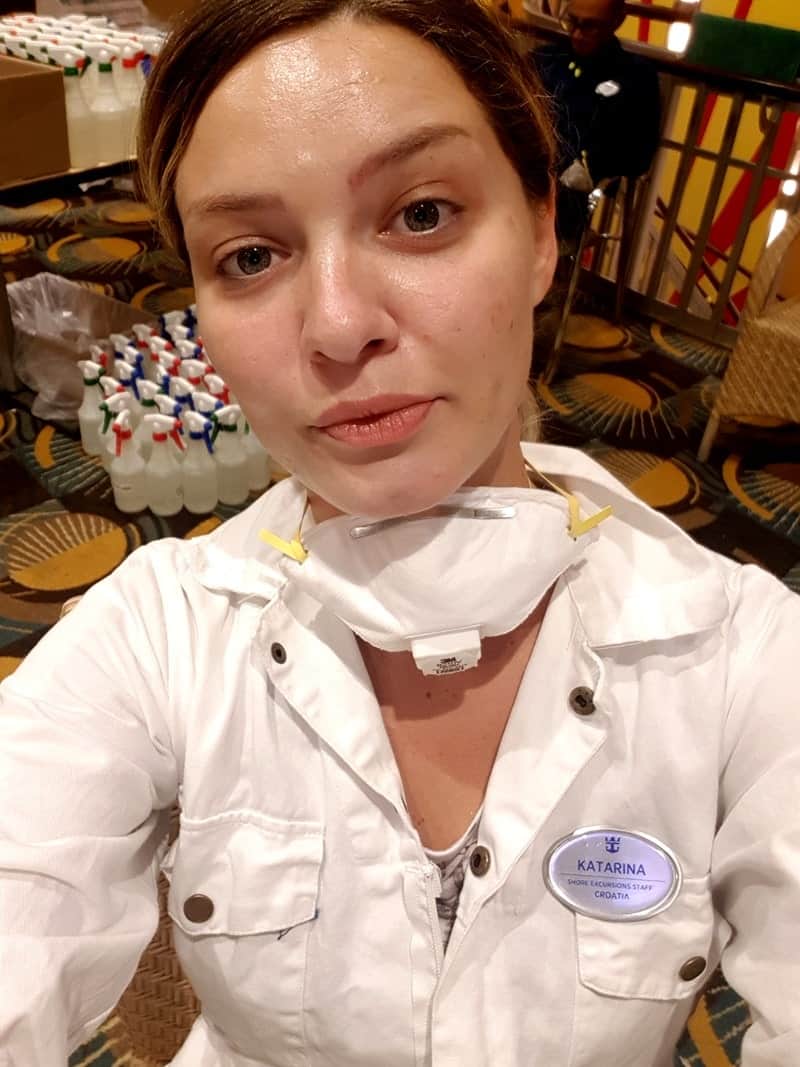
However, a dry dock is an interesting and unique experience, that has both positive and negative sides for crew members.
Positive Sides Of a Dry Dock (For Crew Members)
A Time-Off
For those crew members who don’t enjoy their cruise ship job, this is a time-off period. The ship doesn’t sail and there are no passengers on board, so crew members can get some time off. They do get some other duties, but those duties don’t take up as much time as their job duties. For example, when we were doing fire watch and dispatch, we had a 6-hour shift, which means that you work 6 hours and then after that you’re free. Of course, this doesn’t refer to the crew members who were performing their regular job duties, as some of them were required to do both their regular jobs and fire watch duties.
Single Cabins
During the cruise ship dry dock, you might get lucky and get a single cabin (if you already don’t have one), as the ship doesn’t have as many crew members as usual.
Free Internet
This varies depends on the cruise lines. Sometimes they provide you with free internet, and sometimes not. When my ship was in a dry dock, we had free internet during night hours, and regular internet package prices were discounted.
Crew Parties & Activities
Depending on the location of a cruise ship dry dock and the HR team on board, the ship management often organizes crew parties and different types of activities in order to keep crew members entertained. Crew parties are sometimes organized on board, but mostly outside. My ship was at a dry-dock in Freeport, Bahamas, and we had several parties organized outside for all crew members, which was fun and memorable.

Time to Explore Destinations
Sometimes, dry docks are located in the middle of nowhere (like the one in Freeport – the town center was away a 30-minute drive), or near the city center (like the port of Cadiz, in Spain). Cruise ship dry docks can be located nearby beautiful destinations which gives you the opportunity to explore them and have more time to spend there. My colleagues whose ship was in dry dock in Cadiz were bragging they were going out every night and organized the tours by themselves to explore the area, etc. This all depends on the free time you get and your duties onboard.
Access to Public Spaces
During the dry dock, there are no passengers on board and crew members have access to the public areas such as the dining room (we used to have breakfast in the dining room) or buffet-style restaurant normally accessible only to the guests and officers. When my cruise ship was in the dry dock, we could freely walk around the ship, used the pool deck (when it wasn’t under maintenance) and other areas. It was truly impressive to see how the whole cruise ship changed its looks; the sports bar, laser tag area, the gym, and many others were transformed into new cabins, restaurants, bars, entertainment places. It was a once-in-a-lifetime opportunity to witness such a massive transformation.
You Still Get Paid
You still get your regular salary, but this time no tips involved.
Negative Sides of a Dry Dock (for Crew Members)
Cruise Ship Extra Duties
Firewatch doesn’t sound fun, right? Well, to be honest, from my perspective, it isn’t. Usually, it involves a lot of standing with a lot of dirt and dust around you, and if you are not careful enough, it can get dangerous as well. You wear heavy equipment and have to do the things you would probably never do in real life. The whole ship is a construction site and there are construction works taking place throughout the whole ship every day, which doesn’t make a ship a pleasant place to live at.
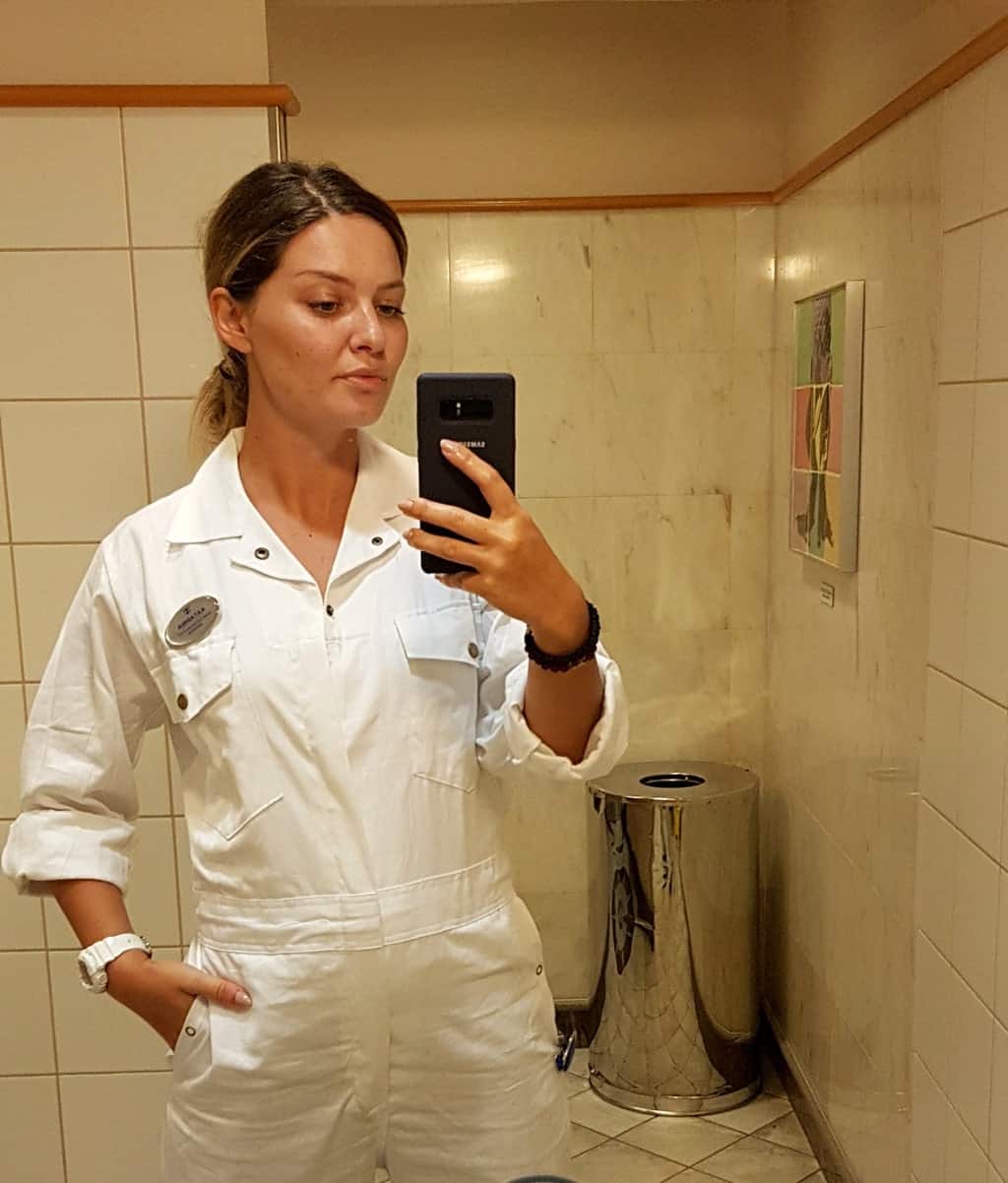
A Lot Of Alarms And Safety Checks Every Day
This literally drove me crazy when my ship was in dry dock. Every day there would be alarms which were not particularly fun when you worked a nightshift and the alarms went off in the early morning. There were many other cruise ship safety checks and inspections, and the rules were much more severe than usual.
Cruise Ship Facilities Malfunction
Due to the ship maintenance, the air-conditioning system, the water supply, and other ship amenities normally don’t work as usual. During the whole dry-dock, I had a weird smell in my cabin (due to the welding, grinding, etc.) and for a few days, we didn’t have water during the night. That’s normal because the whole ship is being refurbished, and maintenance work in progress.
Dry Dock in The Middle of Nowhere
The shipyards can be located far from civilization and your cruise ship might not provide you with any free transportation to reach the nearest town or the city. Shipyard in Freeport is located far from everything, so we were kind of stuck with no way to get into the town. That’s why it’s good to get supplies from the supermarket and purchase all you need BEFORE your ship goes to the dry dock if the dry dock is far from populated places.

These are some of the positive and negative sides I could think of. Nevertheless, the dry dock experience is definitely a unique one and something that I will never forget! Cruise Ship dry docks can be so different in general, and they vary from cruise line to cruise line, that it’s hard to say more in-depth about it. I am sure crew members have had different experiences in regards to it, and feel free to share in the comments below your own dry dock experience.
2. Training And Cruise Ship Safety
Cruise Ship Training
Being a cruise ship crew member involves a lot of rules and regulations that you need to respect and stick to. Once you first join the ship as a new hire, there is a set of various training that you need to attend during the first two weeks of your contract. These training sessions are not only about safety and security topics, but also about cultural differences, ship environment, zero tolerance, alcohol policies, crowd management, and many others.
Once you finish the training sessions, it’s not over. New modules are constantly coming up and all crew members are instructed by their supervisors on new training to attend, which basically means you have to attend pieces of training over and over again, every contract.
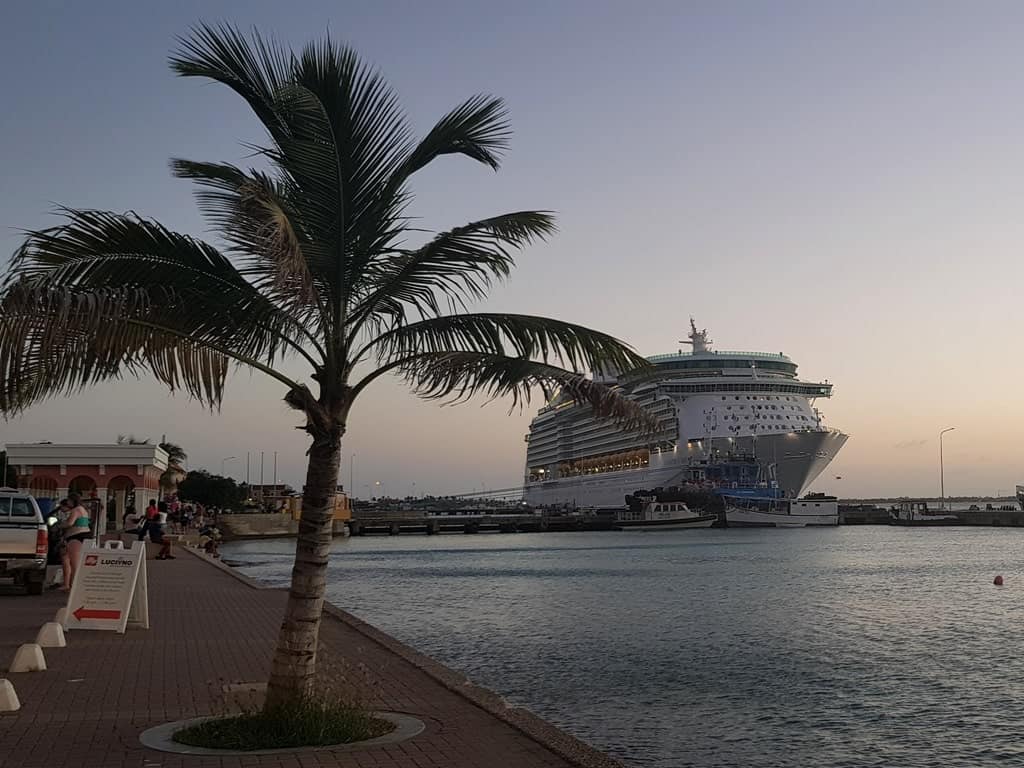
The training sessions can sometimes take up to one hour or more, depends on the type of training. Sometimes you need to physically attend it, and sometimes you do it online. Training is designed for crew members, staff members, and officers, and they vary based on their job position. The main purpose of the training is to keep the crew up to date and further develop their knowledge and skills.
Ship Safety Drills
As I said, working on a cruise ship involves a lot of rules to stick to. Every crew member’s main duty is to ensure the safety of his / her fellow coworkers and passengers, as well as to take care of his / her own safety onboard. In order to be able to act accordingly in case of an emergency, crew members have to attend various mandatory safety and security drills, where they simulate an emergency situation and learn how to act accordingly.
There are different types of crew drills, and every crew member has a designated muster station (the place on the ship where a crew member goes in case of an emergency and is in charge of) to join when the drill starts.
Every crew member also has duties to perform in their muster stations, such as launching a life raft or operating a lifeboat in case of an emergency.

I used to be part of both lifeboat and life raft teams, and my team needed to know everything about how to manage a life raft/lifeboat. I could never imagine myself learning how to drive a lifeboat or launch a life raft, but that was one of my cruise ship duties as well. What can I say, life is full of surprises and unexpected events.
3. Cruise Ship Maintenance
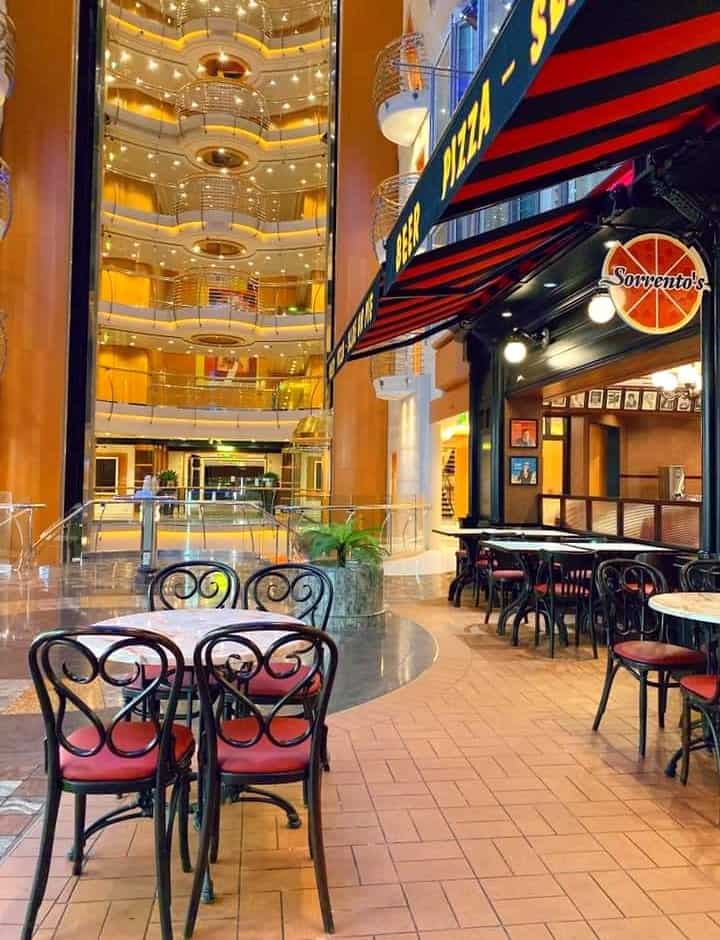
Maintaining the ship’s cleanliness is not only the job of the Housekeeping department: it is the job of all crew members. Every division is in charge of maintaining not only their cabins but also their working areas. There is a schedule to stick to, regarding the sanitizing of the venues, and the ship provides the pre-approved chemicals that you can use for sanitizing. This usually doesn’t take much time but is one of the most important onboard duties.
4. Gangway Duties
Crew members sometimes have to participate in what’s called “gangway duty”. This means that a crew member has to stay outside at the terminal while the ship is in port and help ensure the smooth operation of the embarking and disembarking of every passenger.
Gangway duties are extra duties usually performed by several divisions, such as Casino, Cruise division, Bar division, Next Cruise, and a few others.
One of the gangway duties involves sanitizing the hands of every person coming back to the ship. Crew members in charge have to maintain order, keep people in line at the gangway, and help out the security with getting people inside.
Also, if there are disabled guests or guests in wheelchairs, there are assistance groups to help those guests disembark, and assisting guests is also one of the crew members’ gangway duties.
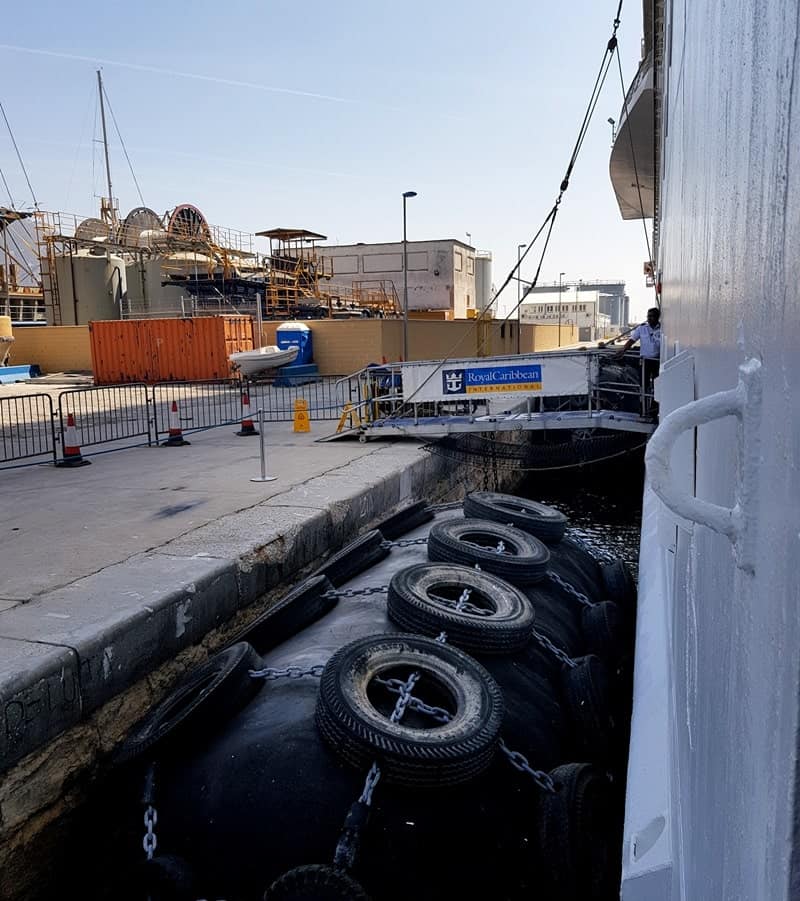
5. Ship Transfer
Based on the cruise line’s and your department’s business needs, you can get transferred to another ship, sometimes to a completely opposite side of the world. Your supervisors are the ones to inform you on that matter, based on the instructions they get from the Head Office. Sometimes, you can be transferred in a couple of weeks or a month, and sometimes they let you know the evening before.
It’s in your interest to obey, as the business needs come first, but you can also ask to stay on the ship you’re currently on (but be ready to get a negative reply). Sometimes, you can switch several ships during the length of a single contract, which can be exhausting but also mentally unhealthy, because as soon as you get used to your team, friends, or even find a girlfriend/boyfriend on board – you have to change the ship. I know people who have been transferred up to six times in a 7-month contract!
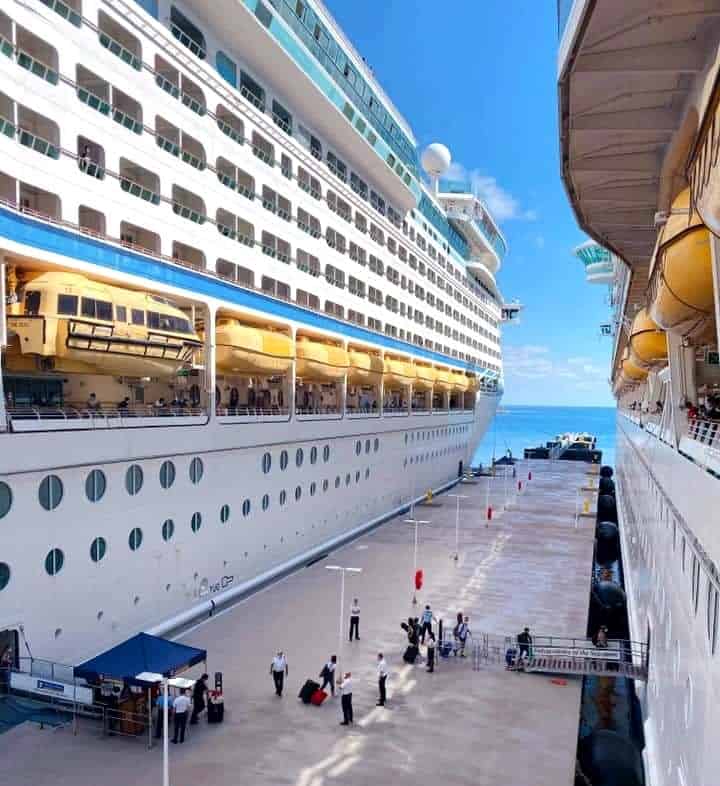
6. Hotel Stay
Ok, maybe I did sound a little bit discouraging in the first few points, but that’s not my intention. Extra duties you get onboard a cruise ship can involve some nice things as well.
Once my friend was supposed to be transferred to another ship but waited in a hotel for 3 days before the ship came to port. He needed to wait in Cartagena for three days and then join the ship he was assigned to.
So, imagine three days off (still paid!) in a nice hotel in Cartagena, with an all-inclusive hotel service, doing nothing. Very nice, right?
Well, that can happen, too (I wish it happened to me; instead, I got only a 2-month dry dock and lifeboat team member card).
7. Cruise Ship Entertainment
Even if you are not a part of the entertaining team onboard (by this, I mean: even if you are not paid to do so), sometimes you’ll be required to perform some entertaining activities for your guests.

For example, in some of the restaurants, the crew members from the Restaurant division have to dance and sing in front of the guests, and perform short shows with the purpose of entertaining the guests. Guests normally like it and enjoy it, it’s fun and boosts up the positive energy and vibes, but when you do it every few days for several months, it can be exhausting.
Also, it happens that the Cruise department (in charge of activities and entertainment) needs help from other departments when organizing entertaining events, so crew members from other departments are required to participate in performances and help them out.
8. Event Attendance
Depending on your job position and division, you have to attend formal events either in the company of your coworkers or cruise ship guests. For this, you’ll need formal clothes which I highly suggest you bring on board with you (I was struggling when I first joined the ship as a new hire, so try not to repeat my mistakes).
It doesn’t have to be a bunch of formal clothes – just always make sure you have at least one piece of formal dress/suit and shoes.
This mostly refers to higher-ranked job positions (management positions, officers…) but it’s always good to be prepared, just in case.

9. Coworkers Assistance
Depending on the HR team, sometimes you have to perform extra duties for your fellow coworkers.
For example, if you are a DJ onboard, you can be also required to play music for crew members in a crew bar (for free), not only for guests. Normally, HR asks you if you want to do it or not, and gives you an option, but sometimes you are required to do so because they have no alternative.
Also, a Cruise division needs to organize events for crew members such as bingo or raffle activities, without being extra paid. What’s more, these activities usually take place late in the evening, when all crew members have some time off to relax, which can be tiring for the crew members in charge.

The same goes for musicians, the restaurant department (they prepare and food for special crew events), and several other divisions.
I find it very nice to try to make your fellow coworkers’ life onboard happier by organizing all those activities, but I also know it can be exhausting as it’s not really part of your job. Most of the crew members don’t look at it as a part of their job – mostly it is all about having good fun and spend a nice time off.
Private Celebrations
Depending on the HR team on board, crew members can also organize their own private celebrations and activities. There are many National day celebrations organized by the crew members of the same nationality, and these can be particularly fun and interesting as they can transform into an authentic event followed by song recitals, costumes, singing, playing of national songs, etc.
The same goes for private celebrations. Your fellow coworkers can ask you to help them with serving the drinks or playing the music for the crew – and in this case, you never really consider it as an extra “duty”; on the contrary, you are happy to help.

10. Sometimes You Pay for Your Uniforms
The way of getting your work uniform depends on a cruise line. Some cruise companies provide uniforms for free, and sometimes you have to buy them, and they can cost hundreds of dollars. As I said, this varies from company to company and is subject to change, but it might be an extra expense you should be aware of.
11. You Can Get Rewarded
You can actually earn extra money onboard. If you do your job well and work a long time for the company, there is a rewarding system that works quite well (but also depends on the company!). You can either be rewarded for your outstanding service, or simply get lucky and win the bingo or raffle, and get a nice amount extra of money or prize, such as a laptop, an iPhone, dinner for your team, etc.
At the end of the dry dock my ship had, in order to thank the crew members, the company organized a raffle with some amazing prizes, and a couple of people won the holidays in the 5* hotel resorts in the world.
Even though it varies, and not all companies are the same (some provide great service for both guests and crew, and some not), the cruise company always finds a way to thank their hard-working employees, and that’s what I truly appreciate when it comes to working on a cruise ship.

To Work on a Cruise Ship – You Need to Be Flexible
To conclude this article, to work on a cruise ship, you have to be flexible. You can’t excuse yourself by saying “that’s not my job”, because any way you’ll do what is required, or otherwise you can get penalized.
When you come on board, it’s a whole new world you need to adapt to and if you truly want a career at sea, you have to accept you’ll have to do much more than just your “real job”.
Life at sea is a lifestyle, a whole new concept of living, and if you choose to live it – accept its rules and adjust your habits and needs accordingly. You’ll make it a lot easier for yourself.
I’d definitely recommend everyone to try, as it can bring you an experience of a lifetime! I think that the experiences you get by working on a cruise ship can’t be compared to any other work experience you have ever had! Not to mention all the fun you have, the destinations you visit, and the people you meet!
For more information on how to apply for a cruise ship job and other important things to know, check out my articles below.



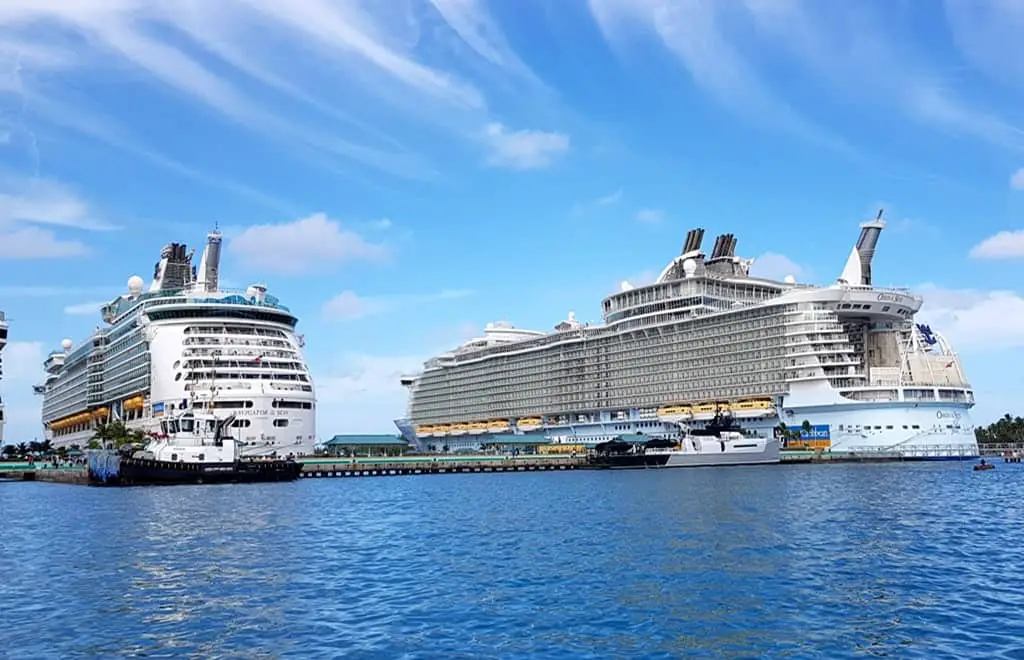


Thanks for this. I was kind of nervous, thinking that it is my first time joining a cruise. I just hope I won’t regret anything. I was supposed to join Celebrity Solstice in March but the Covid-19 Pandemic made it impossible for me, and the rest who were supposed to join that month. Hoping for the resumption of cruises. Keep safe Katarina! 🙂